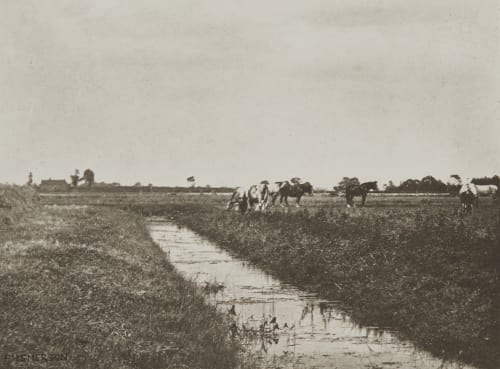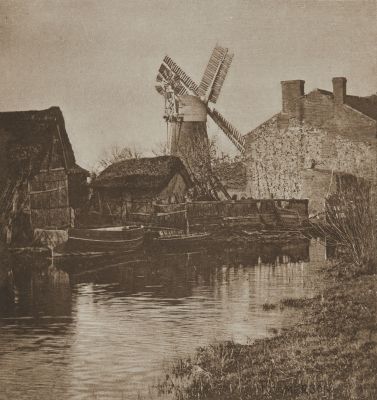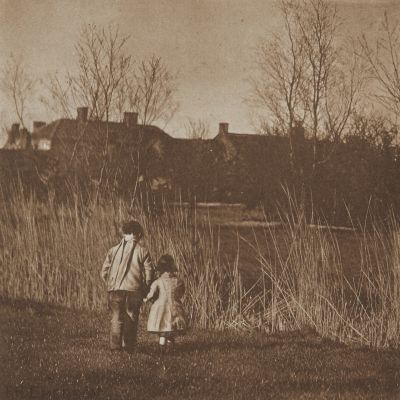
Title
Noontide on the PasturesArtist
Emerson, Peter Henry (British, 1856-1936)Key FigurePublication
Idyls of the Norfolk BroadsDate
1887Process
PhotogravureAtelier
The Autotype Fine Art CompanyImage Size
9.8 x 13.2 cmSheet Size
33.7 x 43.5 cm
From Emerson’s 1887 portfolio, Idyls of the Norfolk Broads, consisting of twelve photogravures (autogravure plates) printed by The Autotype Company. The introduction specifies the plates were ‘unretouched’. A deluxe edition (gold-lettered cover and India plate paper) originally was advertised as limited to 150 copies, but only 100 were actually issued. An ordinary edition was originally advertised as limited to 600 copies, but only 100 were actually issued.
This 1887 portfolio is a poetic portrayal of East Norfolk. Emerson depicts the region as an ‘earthly paradise’ that is in harmony with the changing seasons; from the pleasure of men contemplating the forthcoming harvest in Spring, to the silence of landscape in the snowy Winter, viewers can experience the peacefulness of pastoral life for themselves.
He describes the 12 images within this portfolio as ‘printed from copper plates’ reproduced from his original negatives that were taken directly from Nature – being faithful to what the lens had captured rather than creating artificial composites in the studio or dark room. He also specifies that in the process of reproduction no retouching has marred the subtleties of Nature’s handiwork.
Emerson’s disappointment with the Autotype company eventually led to him learning the process himself and etching and printing his last two books, On English Lagoons (1893) and Marsh Leaves (1895).
Having at last settled on the four apparently most suitable processes [probably referring to the names the firms gave to their individual form of photogravure], we began our studies. Negatives were sent to each of these firms, of whom only one had ever attempted reproducing a landscape direct from a negative from nature. The proofs came, and were in every case most unsatisfactory; they had all been barbarously retouched, all the tonality had been falsified, faces against the sky were made lighter than the sky, faces were roughly outlined with an etching-needle, high lights were scraped away needlessly, and shadows barbarously deepened with the roulette. I think that the comparison of the two plates presented amply demonstrate his problems. However I wonder what firms he contacted as Annan in Glasgow had already done superb work with G. Christopher Davies’ photographs of the Norfolk Broads in 1883, and Dujardin and Goupil had produced photogravures from landscape studies from the early 1870’s on. In many cases the Dujardin and Goupil work showed no or very little retouching. At any rate the Autogravure of the Water Lilies was a disaster. [1]
References
[1] Emerson, P H. Naturalistic Photography for Students of the Art. Sampson Low & Co: London, 1889










